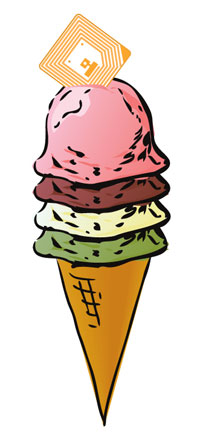To clear up the confusion, first we define RFID as any system that involves the identification of objects—or people, locations, even transactions—remotely via radio waves for the purpose of tracking, monitoring or managing those objects. Active and passive systems are the vanilla and chocolate of RFID, and each has many applications. A real-time locating system (RTLS), for example, can use active or passive RFID to monitor the movement of objects in real or near-real time. Now let’s look at what other technologies you can order at the RFID bar.
Chipless RFID: The term “chipless” is often used to describe RFID systems in which the transponder uses a microchip that’s either printed or made of polymer rather than silicon. They perform the same way as passive RFID systems that use silicon microchips. A real chipless tag system is one in which there is no semiconductor of any kind. Among these are systems that use metal fibers or RF resonant inks. Readers capture a signal and convert it to a serial number to identify an object, so it can be tracked and managed.
Contactless smart card: The Smart Card Alliance claims that contactless smart cards are not RFID, but they clearly are. That’s because the cards use RFID transponders and air interface protocol standards, which govern how tags and readers communicate, to transfer data from the card to the reader. Unlike passive systems used for inventory applications, the tags use encryption to protect data on the card and data transmitted to the reader.
Infrared and ultrasound: These technologies are technically not RFID, in that they don’t use the radio portion of the electromagnetic spectrum—infrared uses light and ultrasound uses sound waves. Systems that use these technologies function similarly to RFID systems: The tag broadcasts an ID and a reader receives it. Light and sound behave differently from radio waves, which make them appropriate for some applications and not for others. Some RTLSs use a combination of RFID and infrared technologies.
Near-Field Communications: NFC is a short-range RFID technology that allows data to be passed back and forth from a reader to a tag. In NFC systems, unlike in other RFID systems, the tag can actually act like a reader and collect data.
RFID sensor networks: Each sensor in these networks has its own power source and a unique ID. If a sensor doesn’t have a unique ID—or if the unique ID isn’t used to determine which object or location is, say, hot or cold—the device is simply a wireless sensor. The sensors communicate with each other, forming a mesh network, and one node passes the data to a computer connected to back-end systems.
Wi-Fi: The Wi-Fi system that allows your laptop to connect to the Internet isn’t RFID. But a Wi-Fi network can be used to identify and track the approximate location of people or objects. Several companies have developed tags that transmit their ID to a base station, and software that uses the ID to locate the tagged object.
RFID Journal will continue to serve up information on all flavors of RFID.


